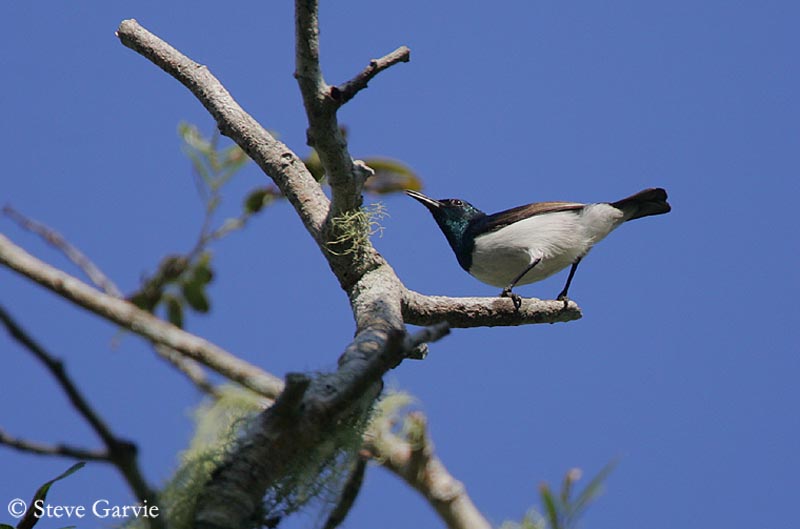
Amani Sunbird
Hedydipna pallidigaster
Passeriforme Order – Nectariniidae Family
BIOMETRICS :
Length : 8-9 cm
Weight : 6-8 g
DESCRIPTION :
Amani Sunbird is a very small sunbird, often observed in treetops.

Adult male has glossy blue-green head, throat and upper breast.
Upperparts are iridescent dark purplish blue-green on upper back, scapulars and upperwing coverts. Lower back and rump are blackish. Short tail and uppertail coverts are glossy purplish-blue.
Underparts are greyish-white, with orange-red feathers on upper flanks. Underwings are white.
The black bill is down-curved. Eyes are dark brown. Legs and feet are black.
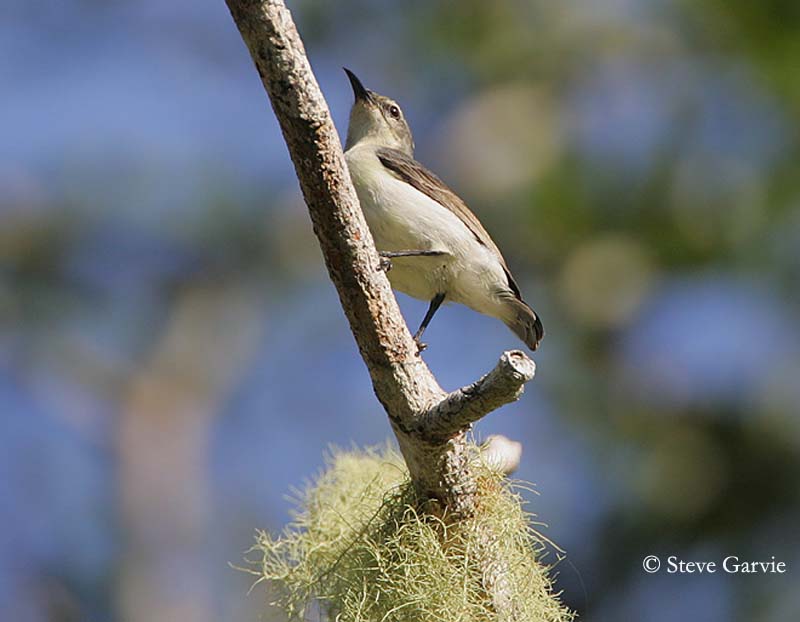
Female is paler than male. She has dark grey upperparts and head sides. We can see a conspicuous white supercilium. She shows some glossy feathers on head and nape, and greenish-grey metallic feathers on wings and tail. Tail is white-tipped. Undertail and underwing coverts are white.
Juvenile resembles female, with pale yellow underparts. Young male shows purple tinge on the throat.
VOICE: SOUNDS BY XENO-CANTO
Amani Sunbird utters a complex song, a series of high-pitched “chissick” sounds and rising and falling chirps.
Call is a “chip”, following a loud “seer-seer”. It also utters a soft “zee-eeee” and “seeet-seeet”.
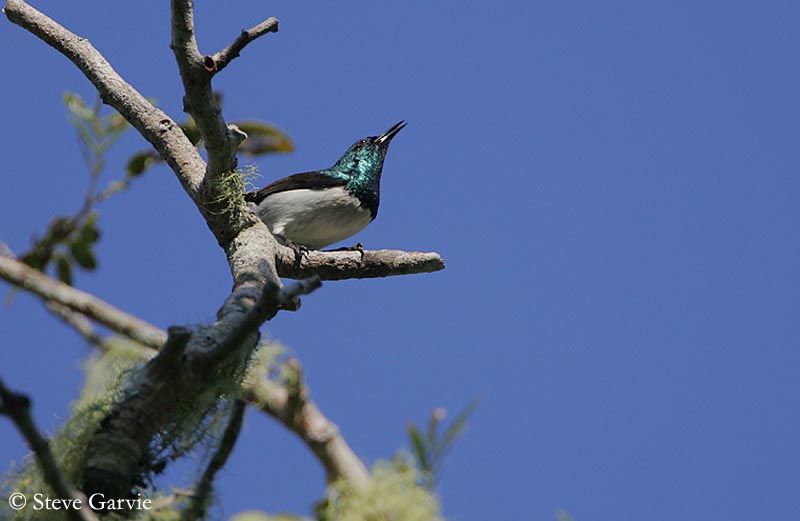
HABITAT:
Armani Sunbird frequents forests, edges and clearings, gardens and degraded forests.
It forages in trees with Spanish moss (Tillandsia usneoides) where it can find numerous invertebrates.
This bird may be found from lowlands up to 1000-1500 metres of elevation.
RANGE:
Amani Sunbird lives in coastal South-east Kenya (Arabuko-Sokoke Forest) and in North-east and Central Tanzania (East Usambaras Mountains and Ndundulu Mountains).
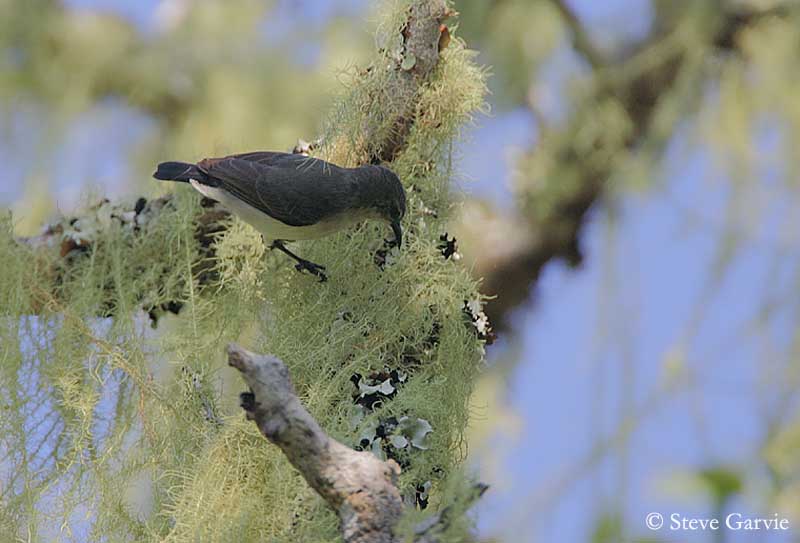
BEHAVIOUR:
Amani Sunbird feeds on caterpillars and spiders, and probably nectar. It may forage alone, in pairs or in groups of up to 60 birds, and also in mixed flocks.
They gather at flowering trees and glean in the canopy, at 5 to 15 metres above the ground. This bird may hang upside-down for reaching its food. It also hawks for flying insects.
Sunbirds have tubular tongue with frayed edges for nectar which is taken by capillary action.
Amani Sunbird performs local and nomadic movements, according to the food resources, mainly in response to their preferred flowering trees.
Sunbirds are usually territorial in breeding season. Male defends the territory by singing, giving advertising calls, and by aggressive displays to other males. It often defends the feeding territory too.
Copulation occurs after the elaborate displays of the male.
FLIGHT:
Amani Sunbird may hover for nectar. It performs fast and direct flight.
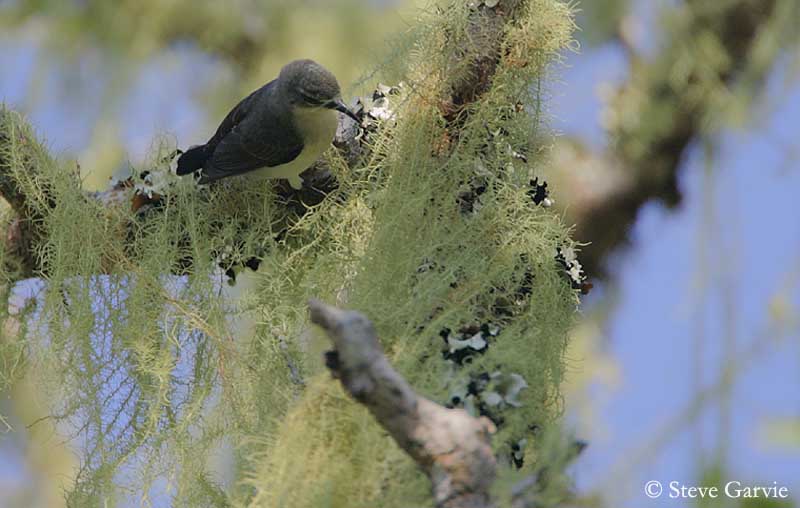
REPRODUCTION:
Breeding season occurs in March, May-June, and September-December.
The nest is suspended up to 7 to 14 metres above the ground, often in Msasa tree (Brachystegia spiciformis). Female builds the nest and needs one week for this work.
It is about 40 cm long, including the “beard” of lichen. It is made with fine plant fibres, lichen and small quantities of plant down.
The interior is lined with soft materials. The nest includes an outer covering and a porch over the side entrance. It is very well camouflaged, thanks to the lichen.
Female lays 3 creamy eggs with brown markings. Incubation is by female alone. Duration of incubation and nestling period is poorly known.
Young are fed by both parents.
DIET:
Amani Sunbird feeds on caterpillars and spiders. It takes nectar from flowers in several trees’ species such as Erythrina, Grevillea and Mistletoe (Loranthaceae).
Amani Sunbirds hawks and sallies for insects. It sits for long periods on a perch, sallies for insects and returns to its perch.
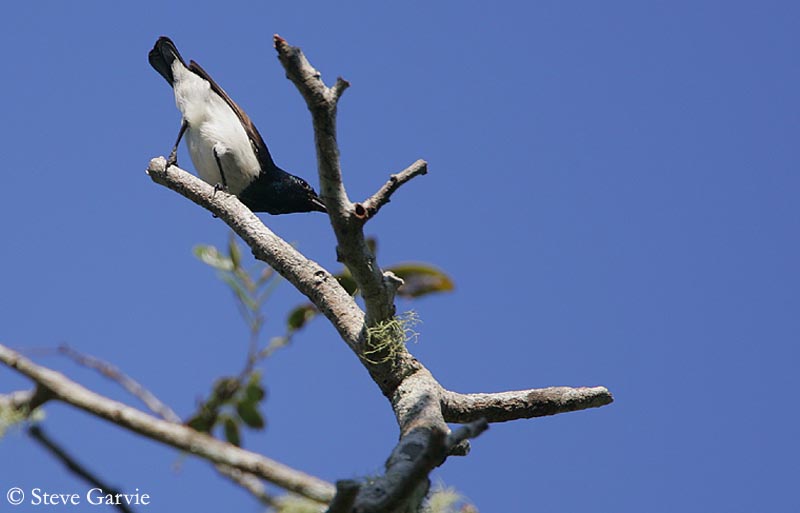
PROTECTION / THREATS / STATUS:
Amani Sunbird is an ENDANGERED SPECIES.
It has very restricted fragmented range in Kenya and Tanzania.
Estimations give about 20.000 Amani Sunbirds, and most of them are threatened by deforestation, causing declines.
Forest conservation programs are in progress in Arabuko-Sokoke, and there are active conservation projects in Tanzania.
Fr: Souimanga d’Amani
All : Amaninektarvogel
Esp : Suimanga de Amani
Ital : Nettarinia di Amani
Nd : Amani-honingzuiger
Photographs by Steve Garvie
His website:
RAINBIRDER Photo galleries
Text by Nicole Bouglouan
Sources :
HANDBOOK OF THE BIRDS OF THE WORLD Vol 12 by Josep del Hoyo-Andrew Elliott-David Christie - Lynx Edicions - ISBN: 8496553423
SUNBIRDS by Roberts A. Cheke, Clive F. Mann and Richard Allen Helm, 2001 - ISBN : 1873403801
Wikipedia (Wikipedia, The Free Encyclopedia)